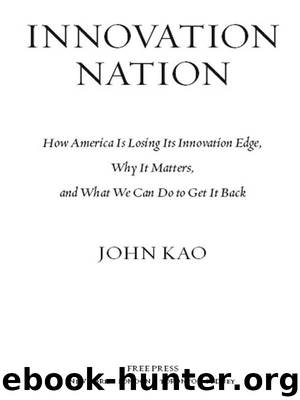Innovation Nation by John Kao

Author:John Kao
Language: eng
Format: epub
Publisher: Simon and Schuster
Published: 2007-07-15T00:00:00+00:00
SEVEN
THE “US” IN USA
In a world of many eyeballs, all bugs are shallow.
—Eric Raymond, open source pioneer
You’ve probably never heard of Yuri Maslyukov. He had the distinction of being the last leader of Gosplan, the huge organization devoted to drawing up the Soviet Union’s five-year plans. Teams of experts high up in the bureaucracy at Gosplan meticulously combed over every statistic and report from industry and agriculture before issuing their directives to the masses below. Surely a collection of brilliant minds with access to oceans of data was a foolproof recipe for economic success. Yet, the former Soviet Union, among other followers of central planning, came to realize that a closed, top-down planning approach was a recipe for disaster.
History shows that closed societies like Stalin’s Soviet Union, Franco’s Spain, and Hitler’s Germany seldom survive much beyond their ruler-driven story lines. Airless throne rooms—whether at Enron or the Kremlin—breed rot and complacency. Soviet music students, a colleague told me, often transcribed a soloist’s improvised notes as they listened to jazz records, then studied them as if they were pieces of music composed in advance by Bach or Chopin. But their rote reproduction completely went against the essence of jazz, which celebrates the free expression of musical talent in the moment. No wonder the centrally planned Soviet Union couldn’t compete with decentralized market economies; the jazz of capitalism simply couldn’t be reproduced in a closed system that relied exclusively on Politburo-dictated five-year plans.
This chapter argues that the nothing is more inimical to the United States’ national innovation agenda than opacity and the belief that those organizations prosper best that control most and hide their knowledge from outsiders. The truth lies almost always precisely in the opposite direction. Thanks in no small part to extraordinary changes wrought by the Internet and related communication technologies, we have discovered that innovation and sizable profits can flow from adding openness to your business model.
Open businesses are increasingly trading ideas with their competitors, customers, and other outsiders, showing a mutual receptivity to new ways of thinking and multiplying innovation and benefits for all participants with unprecedented speed. Companies that know how to encourage the bubbling up of ideas, internally or from an outside community of experts, advisers, or opinionated consumers, will expand their base of imaginative assets. Nokia, Procter & Gamble, Salesforce.com, and Google are just a few of the practitioners of openness as a business model. The mainstream is not far behind. In fact, in a recent study by IBM, CEOs surveyed considered their employees to be the most significant sources of innovative ideas, followed by business partners, customers, consultants, competitors, and trade associations. Internal R & D came in a distant eighth.
Openness, as we now know, is also an essential component of the creative climate that produces national growth and vibrant societies—and it is a climate in which American ingenuity thrives. We have a lot of historical and cultural experience with what might be called “open-source innovation,” the kind that can come from anywhere in a meritocracy of talent.
Download
This site does not store any files on its server. We only index and link to content provided by other sites. Please contact the content providers to delete copyright contents if any and email us, we'll remove relevant links or contents immediately.
Learning SQL by Alan Beaulieu(5447)
Weapons of Math Destruction by Cathy O'Neil(5070)
iGen by Jean M. Twenge(4714)
Digital Minimalism by Cal Newport;(4612)
Sapiens by Yuval Noah Harari(4575)
Elon Musk by Ashlee Vance(3470)
The Age of Surveillance Capitalism by Shoshana Zuboff(3445)
Thing Explainer by Randall Munroe(3350)
Apollo 8 by Jeffrey Kluger(3212)
Future Crimes by Marc Goodman(3015)
The Science Book (Big Ideas Simply Explained) by DK(2762)
Who Can You Trust? by Rachel Botsman(2739)
I Live in the Future & Here's How It Works by Nick Bilton(2540)
Infinite Energy Technologies by Finley Eversole(2501)
Steve Jobs by Walter Isaacson(2458)
Dawn of the New Everything by Jaron Lanier(2450)
Chernobyl by Serhii Plokhy(2143)
Energy Myths and Realities by Vaclav Smil(2077)
Ben Franklin's Almanac by Candace Fleming(2071)
